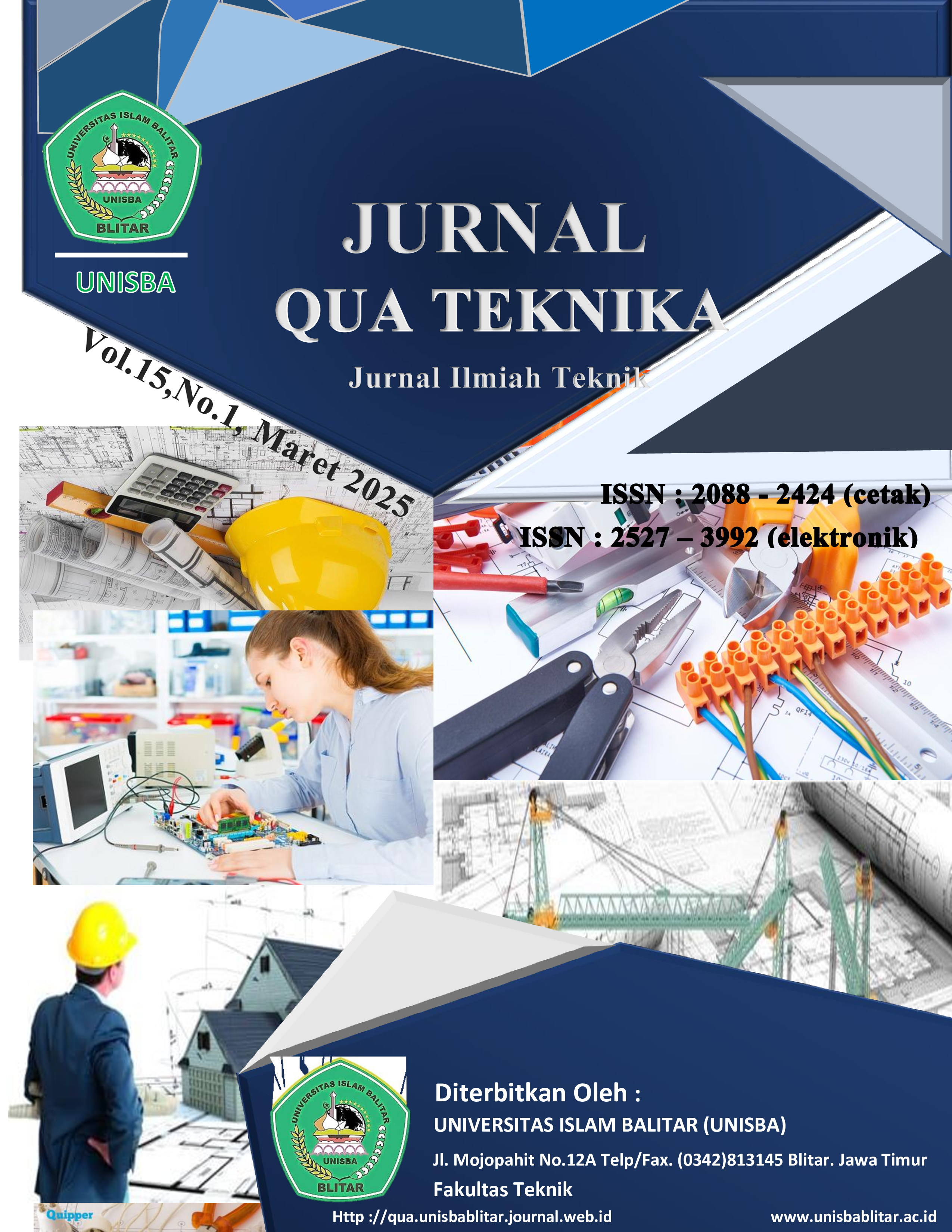RANCANG BANGUN ALAT MINI GAS ANALYZER KENDARAAN BERMOTOR MENGGUNAKAN SENSOR MQ7, MQ6 DAN MIKROKONTROLLER ARDUINO UNO
DOI:
https://doi.org/10.35457/quateknika.v15i01.4366Keywords:
Kata Kunci : Gas analyzer; Karbon Monoksida; Hidrokarbon; Sensor MQ7; Sensor MQ6; Pengujian Emisi.Abstract
Abstract: Motor vehicle exhaust is a major contributor to air pollution and can have a negative impact on health and the environment, so it is important to have a vehicle exhaust gas measurement tool, to ensure that vehicle exhaust is at the tolerance level set by the government. This study aims to create a mini gas analyzer tool based on Arduino Uno that can measure carbon monoxide (CO) and hydrocarbon (HC) levels in motor vehicle exhaust. The tool design uses an MQ7 sensor to measure CO and an MQ6 sensor to measure HC and Arduino Uno as a data processor. Tool testing was carried out by experimenting with several vehicles with different engine conditions. The test results showed an average error of 1.89% for CO and 0.375% for HC when compared to conventional tools. The test results show the potential of the tool for use in mass emission testing programs
Keywords: Gas analyzer; Carbon Monoxide; Hydrocarbon; MQ7 Sensor; MQ6 Sensor; Emission Testing.
References
Ismiyati, I., Marlita, D., & Saidah, D. (2014). Pencemaran udara akibat emisi gas buang kendaraan bermotor. Jurnal Manajemen Transportasi & Logistik (JMTransLog), 1(3), 241-248.
Sarungallo, S. K., Putu, G., Agung, R., & Jasa, L. (2019). Rancang bangun alat ukur uji emisi gas karbon monoksida (CO) berbasis mikrokontroler. Teknologi Elektro, 16(1).
Kosegeran, V. V., Kendekallo, E., Sompie, S. R., & Bahrun, B. (2013). Perancangan alat ukur kadar karbon monoksida (CO), karbon dioksida (CO2), dan hidrokarbon (HC) pada gas buang kendaraan bermotor. Jurnal Teknik Elektro dan Komputer, 2(3), 50-56.
Ikhsan, I. (2017). Implementasi Arduino dalam rancang bangun alat uji emisi kendaraan bermotor berbasis Android. Jurnal Ilmu Komputer, 6(1), 1-7.
Setyawan, R., Dewanto, Y., & Zariatin, D. (2018). Prototipe alat deteksi kandungan CO dan HC dalam kabin kendaraan menggunakan mikrokontroler Arduino. Teknobiz: Jurnal Ilmiah Program Studi Magister Teknik Mesin, 8(2), 55-60.
Krismana, C., Auliq, M. A., & Rintyarna, B. S. (2022). Perancangan detektor gas karbon monoksida (CO) dan hidrokarbon (HC) dengan sistem air purifier berbasis Arduino. Jurnal Teknik Elektro dan Komputasi (ELKOM), 4(2), 169-178.
Aldhareva, P., & Risfendra, R. (2020). Alat uji emisi portabel kendaraan bermotor. JTEV (Jurnal Teknik Elektro dan Vokasional), 6(1), 262-270.
Michelle, E., Jusuf, M., & Julian, J. (2021). Efektivitas pelaksanaan kebijakan berdasarkan Pergub No 66 Tahun 2020 tentang uji emisi kendaraan bermotor di Jakarta. ADIL: Jurnal Hukum, 12(1).
Agung Putu, et al. (2022). Pengaplikasian Internet of Things (IoT) dalam manufaktur industri farmasi di era Industri 4.0. Farmaka: Jurnal Fakultas Farmasi, 20(1).
Triana, N., Mudini, M., & Putra, G. A. (2023). Rancang bangun kendali perangkat elektronik rumah secara wireless berbasis Arduino. JTIM: Jurnal Teknik Informatika Mahakarya, 6(2), 79-86.
Manullang, A. B. P., Saragih, Y., & Hidayat, R. (2021). Implementasi Nodemcu Esp8266 dalam rancang bangun sistem keamanan sepeda motor berbasis IoT. Jurnal Informatika dan Rekayasa Elektronik, 4(2), 163-170.
Ramady, G. D., et al. (2020). Rancang bangun model simulasi sistem pendeteksi dan pembuangan asap rokok otomatis berbasis Arduino. Jurnal Teknik Komputer AMIK BSI, 6(2), 212-218.
Lesmana, Y. L. Y., & Purnama, I. (2023). Rancang alat pengukur tinggi badan dengan output suara berbasis Arduino Uno. Bulletin of Information Technology (BIT), 4(2), 245-252.
Ikhsan, R. N., & Syafitri, N. (2021). Pemanfaatan sensor suhu DS18B20 sebagai penstabil suhu air budidaya ikan hias. In Prosiding Seminar Nasional Energi, Telekomunikasi dan Otomasi (SNETO) (pp. 18-26).
Alfan, A. N., & Ramadhan, V. (2022). Prototype detektor gas dan monitoring suhu berbasis Arduino Uno. PROSISKO: Jurnal Pengembangan Riset Dan Observasi Sistem Komputer, 9(2), 61-69.
Amalia, D. (2021). Belajar mudah pemrograman Arduino.
Fathoni, A., Rizal, Y., & Edi, S. (2023). Kajian emisi gas buang kendaraan roda 4 1300 CC di Kabupaten Rokan Hulu. Aptek, 1-7.
Downloads
Published
Issue
Section
License
Copyright (c) 2025 Jurnal Qua Teknika

This work is licensed under a Creative Commons Attribution-ShareAlike 4.0 International License.
Authors who publish with this journal agree to the following terms:
- Copyright on any article is retained by the author(s).
- Author grant the journal, right of first publication with the work simultaneously licensed under a Creative Commons Attribution License that allows others to share the work with an acknowledgement of the work’s authorship and initial publication in this journal.
- Authors are able to enter into separate, additional contractual arrangements for the non-exclusive distribution of the journal’s published version of the work (e.g., post it to an institutional repository or publish it in a book), with an acknowledgement of its initial publication in this journal.
- Authors are permitted and encouraged to post their work online (e.g., in institutional repositories or on their website) prior to and during the submission process, as it can lead to productive exchanges, as well as earlier and greater citation of published work.
- The article and any associated published material is distributed under the Creative Commons Attribution-ShareAlike 4.0 International License
Deprecated: json_decode(): Passing null to parameter #1 ($json) of type string is deprecated in /home/ejournal.unisbablitar.ac.id/public_html/plugins/generic/citations/CitationsPlugin.php on line 68










